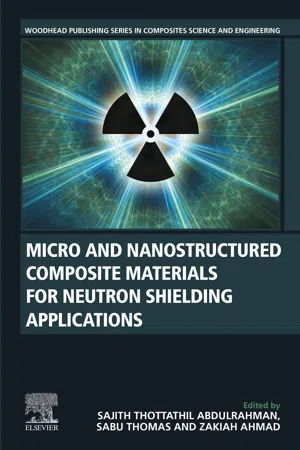
Micro and Nanostructured Composite Materials for Neutron Shielding Applications
- 450 pages
- English
- ePUB (mobile friendly)
- Available on iOS & Android
Micro and Nanostructured Composite Materials for Neutron Shielding Applications
About This Book
Micro- and Nanostructured Composite Materials for Neutron Shielding Applications presents recent developments and future possibilities for neutron shielding materials. Emphasis is placed on the correlation between the morphology, shielding mechanisms, and other desired properties, including their mechanical and thermal properties. The effect of neutron absorbing fillers, including their size on final properties is also examined, as are recent advancements in preparation, characterization and simulation techniques. Written by specialists in their respective fields, this comprehensive resource will help professionals and students understand the fundamentals of neutron shielding, as well as the properties of micro- and nanopolymer-based composites, concrete materials, alloy materials and metal-ceramic composites.
- Provides an up-to-date understanding of the fundamentals of shielding mechanisms, morphology and material property correlations
- Covers a broad range of micro and nano composite materials for neutron shielding
- Discusses recent advances surrounding the synthesis and processing of nanostructures and nanocomposite materials
Frequently asked questions
Information
Introduction to neutron-shielding materials
b International and Inter University Centre for Nanoscience and Nanotechnology, Mahatma Gandhi University, Kottayam, Kerala, India
Abstract
Keywords
1.1 Introduction
| Sl. no. | Categories | Energy of neutrons | Shielding material | Reference |
|---|---|---|---|---|
| 1. | Nuclear power plants | > 2 MeV | Concrete wall | [3–5] |
| Water (moderator) | ||||
| Polymer composites | ||||
| Metal cask (spent fuel) | ||||
| 2. | Medical hospitals | 10–25 MeV | Concrete wall | [6–9] |
| Metal composites | ||||
| Polymer composites | ||||
| 3. | Aerospace | > 1 MeV | Polymer composites | [10–12] |
| 4. | Neutron radiography | ~ 4 MeV | Polymer composites | [13–17] |
| Neutron activation analysis | ||||
| Active neutron interrogations |
Table of contents
- Cover image
- Title page
- Table of Contents
- Copyright
- Contributors
- Editors biography
- Chapter 1: Introduction to neutron-shielding materials
- Chapter 2: Review on neutron-absorbing fillers
- Chapter 3: Thermoplastic micro- and nanocomposites for neutron shielding
- Chapter 4: Thermosetting micro- and nanocomposites for neutron radiation shielding
- Chapter 5: Elastomeric micro- and nanocomposites for neutron shielding
- Chapter 6: Metal and alloy composites for neutron shielding
- Chapter 7: Shielding concrete with neutron attenuating and absorbing components
- Chapter 8: Neutron shielding concrete in medical applications
- Chapter 9: Advancements in shielding materials for spent fuel storage
- Chapter 10: Neutron radiation shielding composites for deep space exploration: An introduction
- Chapter 11: Functional characterization of neutron-shielding materials
- Chapter 12: Advanced multilayer composite structures for fast neutron detection and shielding protection applications
- Chapter 13: Neutron spectroscopy techniques
- Chapter 14: Advancements in computational methods for neutron shielding
- Chapter 15: Effect of spent nuclear fuel neutron aging on dry cask shielding material
- Index
